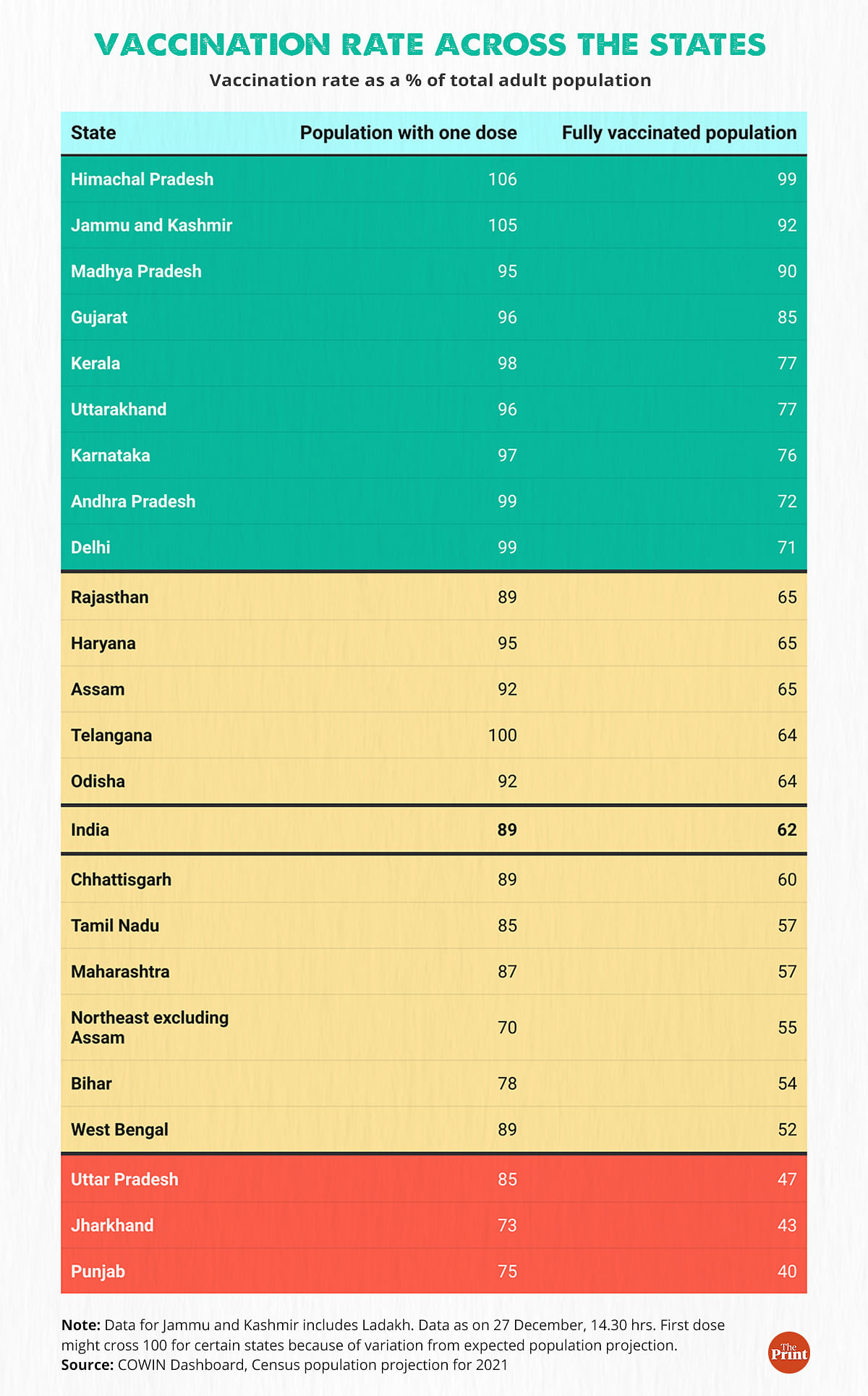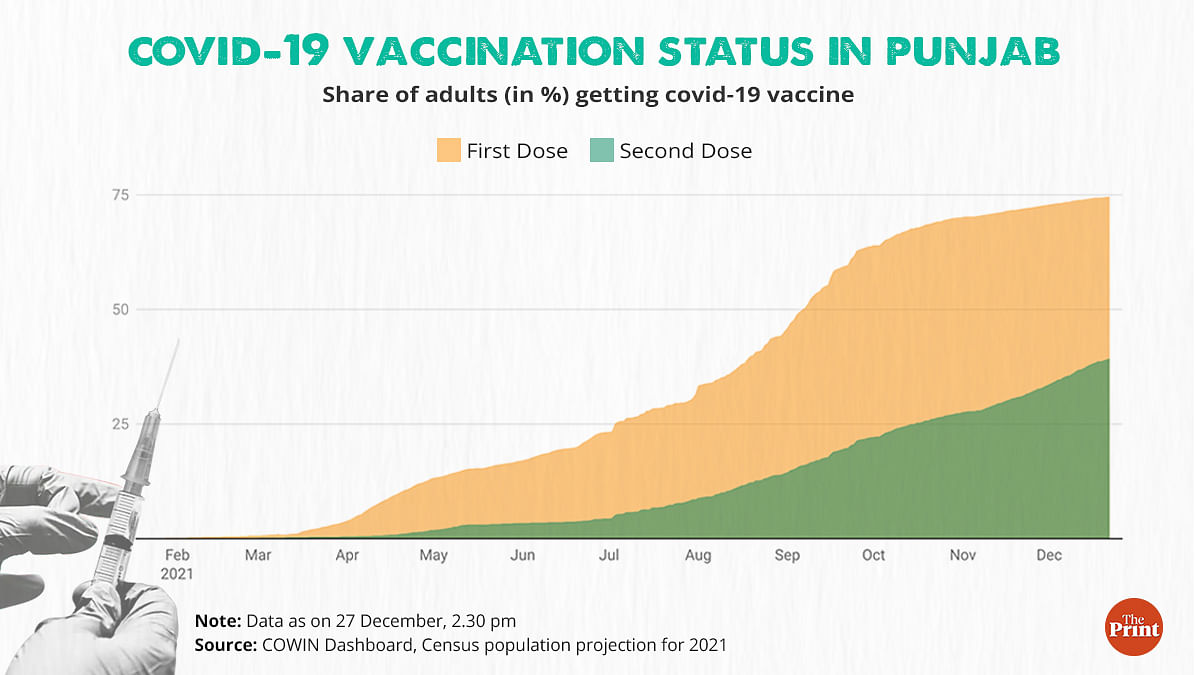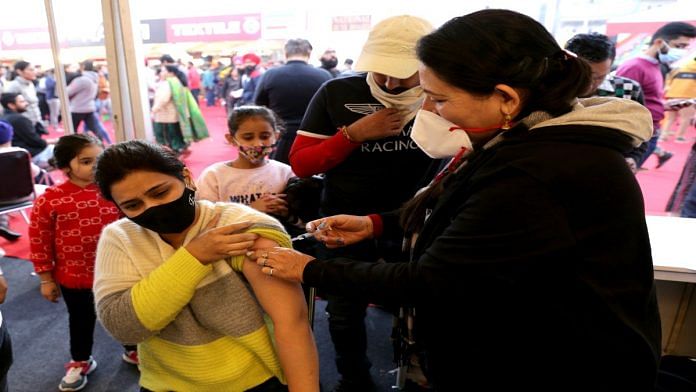New Delhi: Punjab, where the assembly elections are scheduled early next year, has the lowest percentage of fully vaccinated adults compared to other states at present, shows the government’s vaccination data on its web portal CoWIN.
As of 27 December, around 89 lakh people in the state had received the second vaccine shot for Covid-19. According to the Census population projections for 2021, Punjab has an estimated adult population of 2.27 crore, which means that just about 40 per cent of the total adult population has been fully vaccinated.
Currently, India is using vaccines that require two doses over a stipulated interval to activate their full potential. Besides Punjab, only two other large states — Uttar Pradesh (47 per cent) and Jharkhand (43 per cent) have less than half of their population fully vaccinated.
Himachal Pradesh, Jammu & Kashmir, Madhya Pradesh, Gujarat, Kerala, Uttarakhand, Karnataka, Andhra Pradesh and Delhi have already administered both vaccine shots to at least two-thirds of their adult population.
On average, around 62 per cent of India’s estimated 94 crore adults have received both shots of the vaccine.

In June this year, the Indian government had envisaged vaccinating the entire country by the end of 2021. With more than a third of the country’s population yet to get their second shots at varying dates, achieving this target seems unlikely.
Sources in the Punjab health department told ThePrint on condition of anonymity that people in the state have become “vaccine indifferent”, which means that it doesn’t matter to them if they are vaccinated or not.
A source also said the ongoing strike of healthcare staff that includes ASHA (accredited social health activist) workers and nurses has affected the pace of vaccination.
Also Read: With ‘precaution doses’ approved in India, here’s what we know about Covid vaccine boosters
‘Worrying situation’
In October this year, ThePrint had assessed the vaccination status of India’s states — which showed that at the time, around 70 per cent of Punjab’s adult population had received at least one shot of the vaccine and only 26 per cent were fully vaccinated.
Two months later, as on 27 December, only 75 per cent of Punjab’s adult population had received at least one shot and around 40 per cent had been fully vaccinated.
“Punjab’s vaccination rate is abysmal compared to most other states. Even larger states like Uttar Pradesh and Bihar, which used to lag behind on vaccination, have now gone past Punjab,” said Rijo M. John, a health economist based in Kerala.
With assembly polls set to take place in the state early next year, low full vaccination poses a threat of a significant Covid wave, he added.
“The impending election and increasing threat from new variants such as Omicron make the case of Punjab particularly worrying. With the potential faster spread of Omicron leading up to the elections, the slow pace of vaccination would mean more adverse outcomes in Punjab compared to other better-vaccinated states,” Rijo further said.

In the first 27 days of September, at the peak of vaccination administration, Punjab was providing around 2 lakh doses per day (1.5 lakh first doses, 50,000 second doses). At present, the state is vaccinating at about one-third of the pace — 68,000 doses daily (16,000 first doses, 52,000 second doses), according to CoWin data.
Slow vaccination may delay fight
Besides Punjab, Jharkhand and Uttar Pradesh, the states of Chhattisgarh (60 per cent), Tamil Nadu (57 per cent), Maharashtra (57 per cent), Bihar (54 per cent), West Bengal (52 per cent) and the north-eastern states (excluding Assam) clubbed together (55 per cent) — have a lower average rate of vaccination compared to the national figure.
Clubbed together, these regions host around 55 per cent of India’s adult population and only a little more than half of them have been fully vaccinated.
The silver lining is that 84 per cent of adults in most of these states have received at least one shot, which means that by March next year, all of them will likely be fully vaccinated.
Even so, the entry of a new variant — Omicron — in less than a year since the Delta variant caused havoc, has led to new worries.
“It is clear that Omicron will take over the Covid-19 landscape and it is also clear that even though it is effective in evading immunity, vaccination does help to blunt the impact of an infection,” Gautam Menon, professor of physics and biology at Ashoka University in Sonepat, Haryana, told ThePrint.
High levels of comorbidities also become a matter of concern due to low rate of vaccination in Punjab, he said.
“To be sure, the relatively high levels of seropositivity that the state has recorded in the last ICMR serosurvey will provide some measure of immunity to the public at large. However, this could have been further enhanced with a more widespread vaccination program,” Menon added. “Of some concern is the high level of comorbidities in the state, which would predispose someone infected to a more serious outcome. It is still not too late to vaccinate on a war footing,” he said.
(Edited by Gitanjali Das)
Also Read: ‘Supply shortage, hesitancy, reluctance to pay’ — why Punjab did poorly on Covid vaccination



